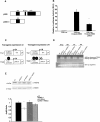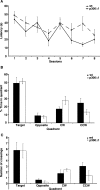Transgenic mice expressing an inhibitory truncated form of p300 exhibit long-term memory deficits
- PMID: 17761541
- PMCID: PMC1994075
- DOI: 10.1101/lm.656907
Transgenic mice expressing an inhibitory truncated form of p300 exhibit long-term memory deficits
Abstract
The formation of many forms of long-term memory requires several molecular mechanisms including regulation of gene expression. The mechanisms directing transcription require not only activation of individual transcription factors but also recruitment of transcriptional coactivators. CBP and p300 are transcriptional coactivators that interact with a large number of transcription factors and regulate transcription through multiple mechanisms, including an intrinsic histone acetyltransferase (HAT) activity. HAT activity mediates acetylation of lysine residues on the amino-terminal tails of histone proteins, thereby increasing DNA accessibility for transcription factors to activate gene expression. CBP has been shown to play an important role in long-term memory formation. We have investigated whether p300 is also required for certain forms of memory. p300 shares a high degree of homology with CBP and has been shown to interact with transcription factors known to be critical for long-term memory formation. Here we demonstrate that conditional transgenic mice expressing an inhibitory truncated form of p300 (p300Delta1), which lacks the carboxy-terminal HAT and activation domains, have impaired long-term recognition memory and contextual fear memory. Thus, our study demonstrates that p300 is required for certain forms of memory and that the HAT and carboxy-terminal domains play a critical role.
Figures





Similar articles
-
Altered memory capacities and response to stress in p300/CBP-associated factor (PCAF) histone acetylase knockout mice.Neuropsychopharmacology. 2008 Jun;33(7):1584-602. doi: 10.1038/sj.npp.1301551. Epub 2007 Sep 5. Neuropsychopharmacology. 2008. PMID: 17805310 Free PMC article.
-
Nuclear calcium/calmodulin regulates memory consolidation.J Neurosci. 2004 Dec 1;24(48):10858-67. doi: 10.1523/JNEUROSCI.1022-04.2004. J Neurosci. 2004. PMID: 15574736 Free PMC article.
-
Spatial memory consolidation is associated with induction of several lysine-acetyltransferase (histone acetyltransferase) expression levels and H2B/H4 acetylation-dependent transcriptional events in the rat hippocampus.Neuropsychopharmacology. 2010 Dec;35(13):2521-37. doi: 10.1038/npp.2010.117. Epub 2010 Sep 1. Neuropsychopharmacology. 2010. PMID: 20811339 Free PMC article.
-
Transcriptional/epigenetic regulator CBP/p300 in tumorigenesis: structural and functional versatility in target recognition.Cell Mol Life Sci. 2013 Nov;70(21):3989-4008. doi: 10.1007/s00018-012-1254-4. Epub 2013 Jan 11. Cell Mol Life Sci. 2013. PMID: 23307074 Free PMC article. Review.
-
Hippocampus-dependent memory formation: do memory type-specific mechanisms exist?J Pharmacol Sci. 2005 Jul;98(3):191-7. doi: 10.1254/jphs.crj05005x. Epub 2005 Jun 19. J Pharmacol Sci. 2005. PMID: 15968141 Review.
Cited by
-
From Linkage Studies to Epigenetics: What We Know and What We Need to Know in the Neurobiology of Schizophrenia.Front Neurosci. 2016 May 11;10:202. doi: 10.3389/fnins.2016.00202. eCollection 2016. Front Neurosci. 2016. PMID: 27242407 Free PMC article. Review.
-
Targeting specific HATs for neurodegenerative disease treatment: translating basic biology to therapeutic possibilities.Front Cell Neurosci. 2013 Mar 28;7:30. doi: 10.3389/fncel.2013.00030. eCollection 2013. Front Cell Neurosci. 2013. PMID: 23543406 Free PMC article.
-
Subregion-specific p300 conditional knock-out mice exhibit long-term memory impairments.Learn Mem. 2011 Feb 23;18(3):161-9. doi: 10.1101/lm.1939811. Print 2011. Learn Mem. 2011. PMID: 21345974 Free PMC article.
-
Beyond transcription factors: the role of chromatin modifying enzymes in regulating transcription required for memory.Learn Mem. 2008 Jun 26;15(7):460-7. doi: 10.1101/lm.917508. Print 2008 Jul. Learn Mem. 2008. PMID: 18583646 Free PMC article. Review.
-
Epigenetics of neural repair following spinal cord injury.Neurotherapeutics. 2013 Oct;10(4):757-70. doi: 10.1007/s13311-013-0228-z. Neurotherapeutics. 2013. PMID: 24081781 Free PMC article. Review.
References
-
- Abel T., Nguyen P.V., Barad M., Deuel T.A., Kandel E.R., Bourtchouladze R. Genetic demonstration of a role for PKA in the late phase of LTP and in hippocampus-based long-term memory. Cell. 1997;88:615–626. - PubMed
-
- Alarcon J.M., Malleret G., Touzani K., Vronskaya S., Ishii S., Kandel E.R., Barco A. Chromatin acetylation, memory, and LTP are impaired in CBP+/− mice: A model for the cognitive deficit in Rubinstein-Taybi syndrome and its amelioration. Neuron. 2004;42:947–959. - PubMed
-
- Bailey D.J., Kim J.J., Sun W., Thompson R.F., Helmstetter F.J. Acquisition of fear conditioning in rats requires the synthesis of mRNA in the amygdala. Behav. Neurosci. 1999;113:276–282. - PubMed
Publication types
MeSH terms
Substances
LinkOut - more resources
Full Text Sources
Medical
Molecular Biology Databases
Miscellaneous
